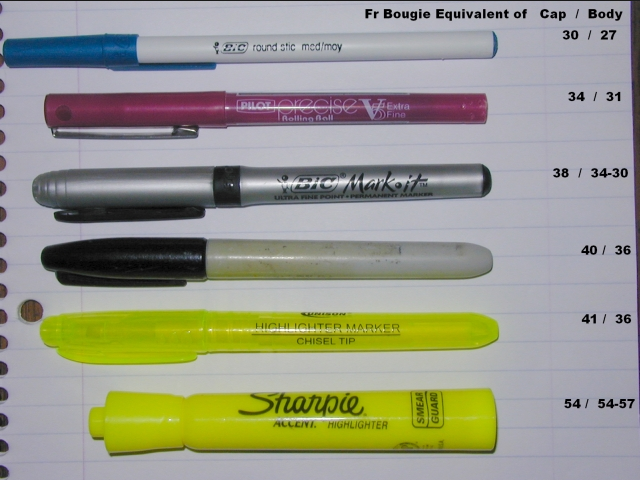The gastric sleeve procedure has become very common in terms of weight loss surgery. In spite of its recent popularity among patients and surgeons it’s still controversial, especially regarding bougie size.
What is a Bougie?
The bougie (BOO-zhee) is a measuring device in the form of a long, flexible tube. Surgeons use it to guide them when dividing the stomach.
During the surgery the bougie is inserted through the mouth and guided through the esophagus and stomach to the pylorus. The tube creates a bulge that the surgeon uses to guide the stapler in dividing the stomach. After the sleeve is formed the bougie is removed.
Bougies come in various sizes and the unit of measurement is called a French, abbreviated F. 1F = 0.333 mm or 1/3 mm. A 40F bougie is equal to ½ inch for example. Standard bougie sizes in the U.S. range from 32 – 50F.
Generally, the smaller the bougie used, the smaller the new stomach size. But the same size bougie doesn’t always create the same size stomach. A lot depends on the surgeon and whether he/she over sews the staple line, and if so by how much.
There is no unanimous agreement on the ideal bougie size for a given patient. This is a challenge because each procedure requires the surgeon to find the size that will be the safest, yet allow for the most amount of weight loss.
The smaller the bougie that is used, the smaller the sleeve and the resulting stomach restriction. But there is a greater risk of leakage and instances of stricture. A stricture occurs when scar tissue develops and interferes with the normal movement of food and liquids into the stomach. It can only be corrected with surgery.
On the other hand, if a larger bougie is used, there is less risk but then maybe less weight loss as well.
2008 Gastric Sleeve Bougie Study
This study showed a very minor difference in weight loss results when using a 40F bougie vs a 60F bougie. At 6 months the difference was less than 2% and at 12 months the difference was less than 6%.
Study: Laparoscopic sleeve gastrectomy: does bougie size affect mean %EWL? Short-term outcomes. Surg Obes Relat Dis. 2008 Jul-Aug;4(4):528-33. doi: 10.1016/j.soard.2008.03.245.)
2013 Gastric Sleeve Surgery Study on Leaks
The results show that bougies of 40F and larger had incidents of leaks with virtually no change in weight loss. Pending further research but caution is recommended in using the smallest possible bougie due to the risks outweighing the benefits.
(Study: The Effects of Bougie Caliber on Leaks and Excess Weight Loss Following Laparoscopic Sleeve Gastrectomy. Is There an Ideal Bougie Size? Obes Surg. 2013 Aug 3. [Epub ahead of print])
2012 Gastric Sleeve Study
Surgeons surveyed reported that in the range of 32F – 50F the most common size being used is 36F, (used by 32% of them). Studies showed that the procedure is relatively safe while there are still variations in bougie size.
(Study: Survey on laparoscopic sleeve gastrectomy (LSG) at the Fourth International Consensus Summit on Sleeve Gastrectomy. Obes Surg. 2013 Aug 4. [Epub ahead of print])
What is the Best Bougie Size for Gastric Sleeve Surgery
Many variables determine bougie size including patient input, their height and weight and of course the surgeon. It’s typically smaller when this is a stand alone procedure (32-50F) rather than a duodena switch (50-60F).
Depending on the bougie size the new stomach will be 60-80% smaller. After surgery the new stomach will hold a meal of ½ cup to 1 ½ cups, rather than the normal 4 – 6 cups.
Before undergoing the sleeve gastrectomy procedure you must discuss bougie size with your surgeon. You need to understand his reasons for recommending the size he intends to use. It’s your stomach and you need to be comfortable.
The sleeve will help reduce hunger and limit food intake, but you need to follow a reduced calorie, nutrient-rich diet if you want to be successful.

